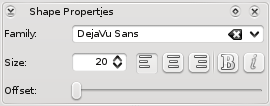Karbon/Tutorials/Artistic Text Shape/nl: Difference between revisions
Wind-rider (talk | contribs) (Created page with "{{Tip|Als een docker niet zichtbaar is, kunt u naar het <menuchoice>Settings -> Dockers</menuchoice> menu gaan, of rechtsklikken op een docker titel, waar u de docker zochtbaar k...") |
Wind-rider (talk | contribs) (Created page with "== Eerste stappen met een text shape ==") |
||
| Line 8: | Line 8: | ||
{{Tip|Als een docker niet zichtbaar is, kunt u naar het <menuchoice>Settings -> Dockers</menuchoice> menu gaan, of rechtsklikken op een docker titel, waar u de docker zochtbaar kan maken.}} | {{Tip|Als een docker niet zichtbaar is, kunt u naar het <menuchoice>Settings -> Dockers</menuchoice> menu gaan, of rechtsklikken op een docker titel, waar u de docker zochtbaar kan maken.}} | ||
== | == Eerste stappen met een text shape == | ||
{|class="tablecenter vertical-centered" | {|class="tablecenter vertical-centered" | ||
Revision as of 14:21, 25 October 2010
Deze tutorial laat zien wat u kunt doen met de . Hoewel deze tutorial gemaakt is aan de hand van Karbon, is de Shape ook in andere KOffice-applicaties beschikbaar en zal deze daar op een vergelijkbare manier werken.
In deze les zult u
- een text shape maken
- een text shape met een path linken
Eerste stappen met een text shape
 |
To add an artistic text shape, go to the docker, click on the icon, and drag it to the canvas. |
After adding the shape, you might want to edit the text and display something more interesting. To do this, you need to activate the , either by double clicking on the newly created shape, or selecting  in the toolbox. Then you can change the text to something like this.
in the toolbox. Then you can change the text to something like this.

After changing the to "Steve", the to 30pt, and setting , you can have the following shape in your canvas:

Path follower
This is still a very straight, flat text. Now we want a curvy text. To do this, we will need to create a path, for instance, using the ![]() .
.
You should have something like this:

To associate the text with the curve, you need to activate the by double clicking on the text, or selecting  .
.
Then, if you move the mouse on top of the curve you will see the cursor changing to a hand, you will need to click on the curve. In the
docker, the icon ![]() is now enabled, and you need to click on it to attach the path. Using the offset in the docker, you can adjust the text to get the following result:
is now enabled, and you need to click on it to attach the path. Using the offset in the docker, you can adjust the text to get the following result:

You can detach the path by clicking on ![]() . You can , and the text. If you change the curve, then the text will be updated.
. You can , and the text. If you change the curve, then the text will be updated.


